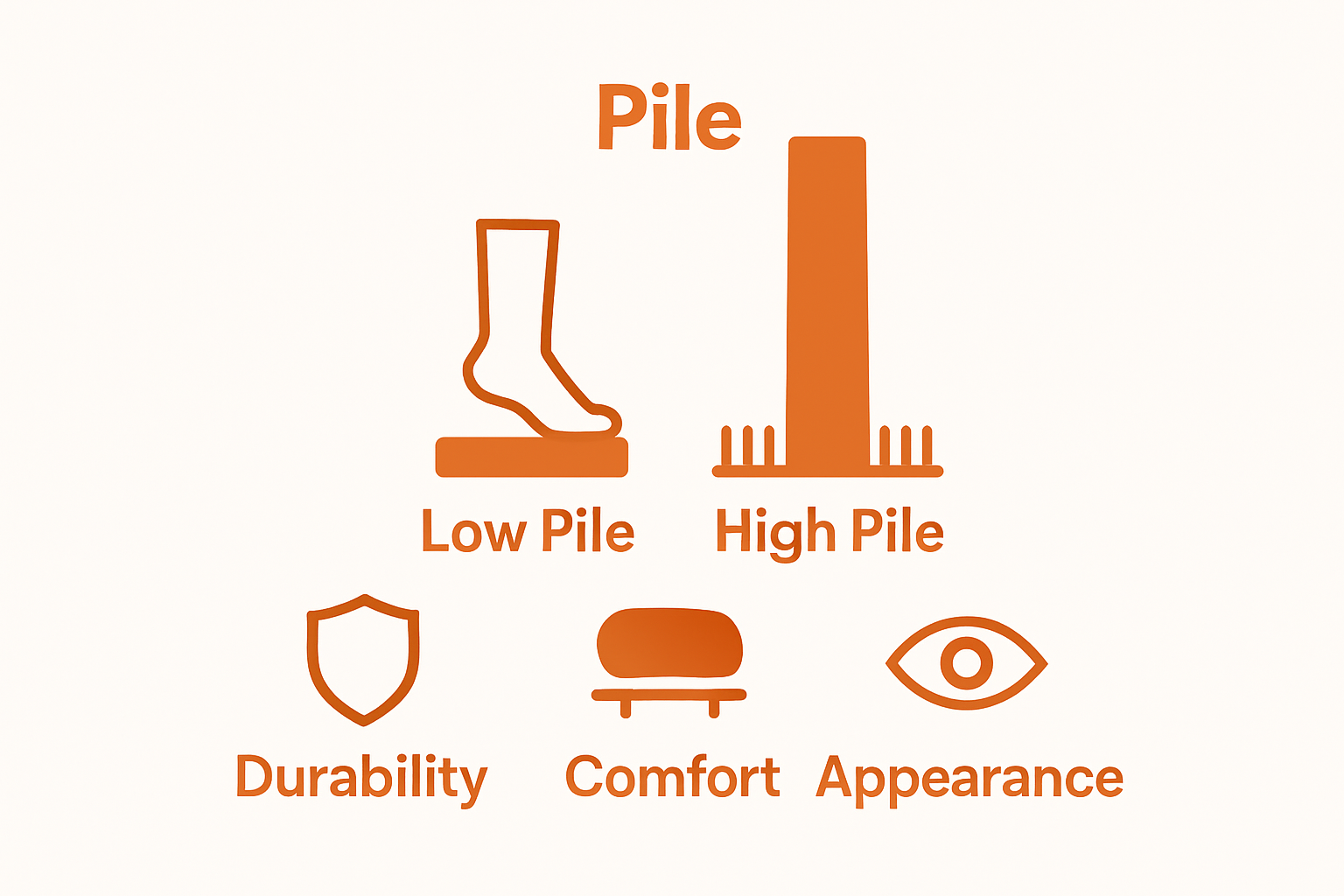
Pile height may sound like a simple technical term. In reality it influences everything from the texture of your living room carpet to the durability of industrial flooring. Yet, most people are unaware that even a small change in pile height can shift material performance in surprising ways. Shorter pile heights often lead to much higher durability in high-traffic areas, while longer fibres may sacrifice resilience for comfort. These hidden differences shape not only how materials look and feel, but also how long they last.
Table of Contents
- Defining Pile Height: The Basics Of Measurement
- The Importance Of Pile Height In Various Industries
- How Pile Height Affects Performance And Durability
- Key Factors Influencing Pile Height Decisions
Quick Summary
| Takeaway | Explanation |
|---|---|
| Accurate measurement is essential for pile height. | Precise measurement ensures material performance and functionality in various applications, influencing quality outcomes. |
| Different industries require specific pile heights. | Pile height specifications vary greatly depending on the intended use, affecting durability and performance. |
| Shorter pile heights enhance durability. | Materials with lower pile heights tend to withstand high-traffic conditions better, making them suitable for demanding environments. |
| Consider environmental factors in selection. | Soil composition and anticipated stress levels impact the decision on pile height and overall material effectiveness. |
| Trade-offs exist between comfort and durability. | Aesthetic and comfort preferences must be balanced against practical performance metrics when selecting pile height. |
Defining Pile Height: The Basics of Measurement
Pile height represents a critical dimensional measurement describing the vertical length of fibrous or textured materials, particularly in flooring and textile contexts. Understanding what is pile height involves recognising its significance across multiple industries, from carpet manufacturing to industrial mat production.
Understanding Pile Height Fundamentals
At its core, pile height measures the length of individual fibres or material strands extending upward from the backing or base layer. This measurement typically occurs from the base surface to the tip of the fibre, providing essential information about material thickness, texture, and potential performance characteristics.
Oklahoma State University emphasises the importance of precise measurement techniques, which apply equally to various material contexts. The measurement process requires careful attention to several key factors:
- Consistent measurement tools
- Standardised measurement angles
- Accurate recording techniques
Practical Applications of Pile Height Measurement
Pile height becomes particularly crucial in sectors where material performance directly correlates with its dimensional properties. In commercial matting, for instance, pile height influences critical attributes such as:
- Durability
- Dirt and moisture retention
- Comfort and cushioning
- Wear resistance
Manufacturers and designers carefully select pile height based on specific environmental requirements, understanding that even minor variations can significantly impact material functionality. A low pile height might provide excellent durability for high traffic areas, while a higher pile height could offer superior comfort and aesthetic appeal in less demanding environments.
By comprehensively understanding pile height measurement principles, professionals can make informed decisions about material selection, ensuring optimal performance across diverse applications.
To help clarify the differences between shorter and longer pile heights, the following table compares their key characteristics and suitability for various environments.
| Pile Height | Durability | Comfort & Cushioning | Suitable Environments | Wear Resistance |
|---|---|---|---|---|
| Shorter | High | Moderate | High-traffic, industrial | High |
| Longer | Moderate/Low | High | Low-traffic, residential | Moderate/Low |
The Importance of Pile Height in Various Industries
Pile height transcends simple measurement, serving as a critical parameter that impacts performance, functionality, and efficiency across multiple sectors. From industrial applications to specialised manufacturing, understanding pile height becomes a strategic consideration for professionals seeking optimal material and equipment performance.
Industrial Performance and Material Selection
In industrial contexts, pile height directly influences material characteristics and operational outcomes. Manufacturers carefully analyse pile height to determine critical performance attributes such as load-bearing capacity, wear resistance, and environmental adaptability.
Agricultural Transport Research highlights the significance of precise pile height measurement in enhancing operational efficiency. Key considerations include:
- Material compression resilience
- Load distribution capabilities
- Thermal and moisture management
- Resistance to mechanical stress
Strategic Applications Across Sectors
Different industries leverage pile height measurement for unique strategic purposes. In construction, pile height determines material durability and insulation properties. Textile manufacturers use pile height to define fabric texture and performance characteristics. Warehouse and logistics operations rely on precise pile height measurements to optimise storage solutions and material handling processes.
Specialised sectors demonstrate remarkable variations in pile height requirements. Agricultural storage systems demand different pile height specifications compared to commercial flooring or industrial matting. Precision in measurement becomes crucial for ensuring optimal performance across these diverse applications.
By understanding pile height as more than a simple dimensional metric, professionals can make informed decisions that directly impact operational efficiency, material performance, and overall product quality. The nuanced approach to pile height measurement represents a sophisticated strategy for enhancing technical capabilities across multiple industrial domains.
How Pile Height Affects Performance and Durability
Pile height plays a pivotal role in determining material performance, serving as a critical factor that influences durability, functionality, and long-term resilience across various applications. Understanding the intricate relationship between pile height and material characteristics allows professionals to make informed decisions about material selection and performance expectations.
Material Compression and Resilience
The vertical dimension of material fibres directly impacts its ability to withstand mechanical stress and maintain structural integrity. Pile height determines how effectively a material can absorb impact, distribute weight, and recover its original shape after compression.
Carpet and Rug Institute research reveals that pile height significantly influences material performance characteristics. Key performance indicators include:
- Compression resistance
- Weight distribution capacity
- Shock absorption capabilities
- Structural recovery potential
Wear Resistance and Longevity Factors
Materials with carefully selected pile heights demonstrate enhanced durability in high-traffic environments. The relationship between pile height and wear resistance is complex, involving multiple interconnected factors such as fibre density, material composition, and environmental conditions.

Shorter pile heights typically offer superior durability in demanding settings, providing more compact and resilient surface structures. Conversely, longer pile heights might offer increased comfort but potentially compromise long-term performance in high-stress scenarios.
Professionals must consider nuanced trade-offs between aesthetic requirements, comfort preferences, and practical performance metrics when selecting materials based on pile height. By understanding these intricate relationships, designers and engineers can optimise material selection for specific environmental challenges, ensuring optimal performance and extended material lifespan across diverse applications.

Key Factors Influencing Pile Height Decisions
Selecting an appropriate pile height represents a complex decision involving multiple interconnected technical and environmental considerations. Professionals must carefully evaluate various factors to ensure optimal material performance and long-term functionality across different applications.
Environmental and Structural Constraints
The selection of pile height is fundamentally influenced by specific environmental conditions and structural requirements. These constraints encompass a wide range of technical parameters that directly impact material performance and durability.
National Academies Press research highlights the critical importance of understanding load resistance and design parameters. Key environmental considerations include:
Below is a summary table capturing the principal environmental and structural factors influencing pile height selection decisions. This overview aids in recognising the broad considerations necessary for professional assessment.
| Factor | Description |
|---|---|
| Soil composition | Affects load-bearing capacity and material foundation suitability |
| Anticipated mechanical stress | Determines required resilience and longevity of material |
| Temperature variations | Fluctuations influence material stability and durability |
| Humidity/moisture exposure | Impacts risk of degradation and affects pile height performance |
| Environmental degradation | Includes potential exposure to chemicals, weather, or wear-and-tear in a given environment |
- Soil composition and load-bearing capacity
- Anticipated mechanical stress levels
- Temperature and humidity variations
- Potential environmental degradation factors
Performance Optimization Strategies
Engineers and designers employ sophisticated strategies to determine optimal pile height, balancing multiple performance metrics. The goal is to create a solution that maximises durability while meeting specific functional requirements.
Critical performance factors involve assessing the interaction between pile height and:
- Material compression characteristics
- Load distribution capabilities
- Thermal and moisture resistance
- Potential wear and tear mechanisms
Successful pile height selection requires a holistic approach that considers both immediate functional needs and long-term performance expectations. Professionals must integrate technical expertise with nuanced understanding of material science, environmental conditions, and specific application requirements to make informed decisions that optimise material performance across diverse industrial contexts.
Transform Your Matting Strategy with the Right Pile Height
Struggling to find floor mats that balance comfort, durability and optimal performance? The article highlighted how crucial correct pile height is for addressing issues like wear resistance, dirt retention and even safety in high-traffic spaces. Choosing the wrong pile height can mean faster wear, poor cleaning results or uncomfortable surfaces. At Mats4U, we understand that every workplace and business environment has unique requirements and that pile height really matters in daily operations.

Let us help take the guesswork out of mat selection. Explore our wide range of custom and industry-specific mats, all designed with essential pile height considerations in mind. Visit Mats4U to discover our floor covering solutions or get in touch for tailored advice. Secure better durability and hygiene for your space now. The right pile height is only a click away.
Frequently Asked Questions
What is pile height?
Pile height refers to the vertical length of fibres or material strands extending upward from the backing of a textile or flooring material. It is a key measurement influencing texture, thickness, and performance characteristics.
Why is pile height important in flooring materials?
The pile height of flooring materials affects durability, comfort, cushioning, dirt and moisture retention, and wear resistance. Different pile heights are suited for specific environments, such as high traffic areas versus more aesthetic applications.
How does pile height affect material performance?
Pile height impacts material performance by influencing compression resistance, weight distribution, shock absorption, and overall structural integrity. Materials with carefully chosen pile heights can perform better under various mechanical stresses.
What factors should be considered when choosing pile height?
When selecting pile height, consider environmental conditions like load-bearing capacity, anticipated stress levels, and moisture resistance. Balancing these factors ensures optimal durability and functionality of the material in its intended application.









